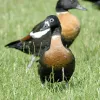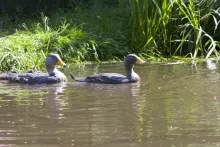
Steamerduck (Magellanic) (Tachyeres pteneres)
Species name
- Dutch name:
- Magelhaen Booteend
- English name:
- Magellanic Steamerduck
- German name:
- Magellan Dampfschiffente
- French name:
- Brassemer cendré
- Scientific name:
- Tachyeres pteneres
Scientific classification
- Order:
- Anseriformes
- Family:
- Anatidae
- Onderfamilie:
- Tachyerinae
- Genus:
- Tachyeres
Description
- Description:
Male:
The head and neck of the males are blue-gray, with paler coloration crown and forehead. The male has a narrow white eye-ring which continuing backwards as stripe and a reddish-brown throat. His abdomen, ventral area and undertail coverts are white and the tail is grey.Female:
Females are darker gray-brown on the head and dark reddish on the throat. Her body and wings as males, but she may have brown/wine coloring on feathers.Bill ,feet and Legs same as male.Juvenile:
Juveniles are similar to the female but slightly duller colored.
- Behaviour:
Highly territorial while breeding. May form small flocks, particularly while moulting, but rarely of more than 25-30 birds. Also aggressive towards Flying steamerduck (Tachyeres patachonicus) and other birds while breeding.
Standard Measurements
- Body Length (cm):
- The male (drake) of the Steamerduck (Magellanic) measures approximately 74-86 centimeters. The female measures approximately 72-83 centimeters.
- Body Weight (grams):
- The male will weight about 5900-6280 gram. The female will weight about 3600-4770 gram.
The weight is notoriously variable and can only be used as indication!
- Note:
Steamerducks are territorial and aggressive, requiring a separate enclosure. A deep and preferably large area of water should be provided. Pelleted food including breeder diet and floating diets have been suggested.
May have been bred extremely rarely in captivity. Close and open ground cover should be provided for nesting.
They become sexually mature at 2 to 3 years of age.
- Breeding:
- The female Steamerduck (Magellanic) usually lays from 5-8 ivory eggs and incubates them for 30-38 days.
- Artificial incubating:
The ideal relative humidity for incubating most waterfowl eggs is 55% (ground nesters) and 40% (cavity nesters). The temperature is usually 37.4°C. Set ventilation as recommended by the incubator manufacturer. Eggs must be turned, either automatically or by hand, a minimum of 4 times a day. As the duckling develops there is a loss of water from the egg and the air sac gets bigger. In normal development of an egg with a 30-38 days incubation, the air sac occupies about a third of it three days earlier. Cleanliness is vital and ideally eggs should be moved to a separate hatcher at this point, where the humidity should be increased to 65% and even higher once they have pipped internally.
- Bird banding:
- Recommended closed leg band ring size for the Steamerduck (Magellanic) is 20 mm.The leg band ring can only be applied on a young flightless duck at around 14-16 days old.
- It doesn't matter what leg that you band, but it's good to have a consistent system. Suggested: Left leg = Female, Right leg = Male
- Maintenance food:
-





Floating full food for all sea ducks, green ducks, eider ducks and geese, especially in the moulting and breeding phase ideally suited. Packed with wholesome raw materials, natural vitamins and trace elements, this performance food with a protein content of 30% forms the basis for lifelong vitality.



